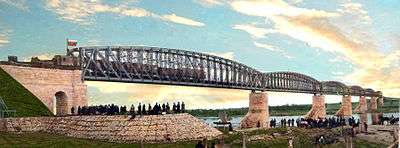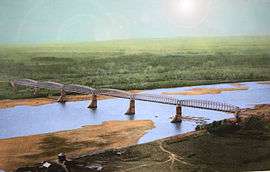Ufa Rail Bridge
| Ufa Rail Bridge | |
|---|---|
|
| |
| Coordinates | 54°43′5.7″N 55°54′28.65″E / 54.718250°N 55.9079583°ECoordinates: 54°43′5.7″N 55°54′28.65″E / 54.718250°N 55.9079583°E |
| Carries | Originally single track it was later widened to double track. |
| Crosses | Belaya river |
| Locale | Ufa, Republic of Bashkortostan, Russia |
| Characteristics | |
| Material | Steel, reinforced concrete, stone |
| Total length | 655.5 m (2,151 ft) |
| History | |
| Designer | Nikolai Beleloubski |
| Construction begin | 1886 |
| Construction end | 1888 |
| Opened | September 8, 1888 |
Ufa rail bridge across the Belaya River carries double tracked rail lines over the Belaya River. It is located in the city of Ufa, the Republic of Bashkortostan, Russia.[1]
Construction
Construction of the bridge began in 1886 and was completed in 1888. The bridge provided for the passage of trains across the Belaya River in the direction of Ufa. Moreover, it became possible to continue building the main railway line up to Chelyabinsk (1892).[2][3]
The design was made by Prof. Nikolai Beleloubski, in compliance with the technical rules of 1884. All steelwork elements were manufactured at the famous Votkinsk ironworks (now the Votkinsk Machine Building Plant) in Udmurtia, where starting from 1871, open hearth furnaces began to be widely used for the first time in Russia that allowed to produce rails for the country's railroad network.
The bridge conisted of 6 spans, each of 109-meter (358 feet) bowstring arch through trusses with double lattice girders. This design involved careful and exact alignment of truss members and chords, which were made from a fairly advanced construction material for that time — cast iron. Beleloubski also proposed an innovative constructive solution: the transverse floor-beams of trusses were hingedly connected to bottom chords. Such a type of structural support was considered to be ground-breaking in the days of Beleloubski, because it allowed to reduce secondary stresses in trusses. This design received the Gold medal at the Edinburg Exposition 1890, and later came to be known as "the Russian support method".[4]

On 8 September 1888, the bridge was solemnly opened to traffic by Minister of Railway Transport, admiral Konstantin Posyet. A pedestrian path was immediately opened on the bridge. For this purpose, special foot sidewalks were made of wood (subsequently the movement of pedestrians was forbidden).
The piers were reinforced by starlings (cutwaters) pointing upstream, to break up pieces of ice floating downstream during the annual spring thaw.[5][6]

In June 1919, the battles of the Russian Civil War took place directly around the town of Ufa. Striving to keep their control over the town at any cost, the retreating troops of Admiral Kolchak detonated the sixth right-bank span of the bridge. One end of the truss fell into the river and was strongly deformed. But this didn't help the Whites to manage their goal, because the famous 25th Rifle Division of Chapaev captured the town on 9 June 1919.
With the retreat of Kolchak in Siberia, the assault troops of the Red Army advanced further, while their rear units remained near Ufa on the other bank of the Belaya.
Meanwhile, the crossing was in urgent need of rehabilitation. Since there were no adequate facilities or equipment available, manual labor was the only hope. It was decided to use winches to raise the fallen truss back into place. Inch by inch, step by step. Perhaps this is how the heavy stones were raised to the height of the rising pyramids of Egypt. But nobody seemed to care about the times of Antiquity.
The restoration works involved approximately 2,500 builders, workers and railway engineers. Day by day, week after week made their work. And the iron mass of the bridge buttressed by scaffolds from a beach didn't towered so hopelessly above the Belaya anymore.
As a result, the bridge was successfully restored in that same year through the establishment of the temporary damaged truss followed by a complete overhaul, during which the destroyed one was replaced with a new structure designed by Prof. Lavr Proskouriakov in compliance with the technical rules of 1907. Proskouriakov designed the largest rail bridges in Russia over the Yenisey and Amur rivers.
Thanks to careful preparation and extraordinary guidance, the bridge builders carried out the replacement of the damaged span with minimal traffic disruption — in just 11 hours. It took 7 hours for pushing the old truss span off the piers with the use of jacking system, and it took 3 hours 45 minutes for putting a new one in place. On October 10, 1919, Vladimir Lenin sent a congratulatory telegram to the bridge-building crew to express his appreciation for their hardwork.[7]
Renovation
There is an old data sheet of the bridge in the archives of the Ufa City Maintenance of Way, which contains the following entry made in 1928:
"...Trains with double headed E class steam locomotives and american gondola cars are not permitted to cross the bridge, during the passage of single headed E class steam locomotives, the maximum speed shall not exceed 8 km per hour (5 miles per hour)".[8]
In the 20th century, the bridge was strengthened and modified several times.
Between 1937 and 1939, the span structures were strengthened with oversize removal and addition of reinforcing metal up to 4 per cent of the weight of the span structures.
Between 1949 and 1951, renovation of the bridge was carried out by the work train №417. On the cutwater side of the piers, pylons for a second track were erected; these were surmounted by unified span structures (designed by Proektstalkonstruktsia in 1944 for class N-7 loads).
The replacement of outdated 'tsarist' span structures with advanced ones for class S-14 loads was done by "Transstroimost" (open joint-stock company) during the period 1991-2001.
Thus, by 2001, all the bridge's spans have been equipped with contemporary steelwork elements, so there is no need to be concerned about the strength of the structure and safety of the crossing.
Bridge across the Ufa River
Ufa rail bridge across the Ufa River carries double tracked rail lines over the Ufa River. It is also located in the city of Ufa, near the station of Urakovo (Shaksha).

Its design and history were almost the same as the bridge over the Belaya River. It was built and "cured" almost the same 2 years later. It was also designed by Prof. Nikolai Beleloubski in compliance with the technical rules of 1884, but had only three spans, each 109 metres (358,432 ft) long.
During the Civil War in 1919, the third left-bank span of the bridge was blown up by the Kolchak troops, and collapsed. The explosion was carried out by artillery firing on cars with explosives previously established in the span.
In 1920, the destroyed structure was replaced with a new one designed by Prof. Proskouriakov in compliance with the technical rules of 1907.
Between 1939 and 1940, the span structures were strengthened with oversize removal and addition of reinforcing metal up to 4 per cent of the weight of the span structures.
Between 1951 and 1952, renovation work on the bridge was carried out by the work train №414. On the cutwater side of the piers, pylons for a second track were erected; these were surmounted by unified span structures (designed by Ghiprotrans in 1931 for class N-7 loads).
The replacement of outdated 'tsarist' span structures with advanced ones for class S-14 loads was done by "USK MOST" (open joint-stock company) during the period 2001-2002.

Interesting facts
- When the bridge was completed in 1888, an artificial channel was dug out to straighten the course of the Dyoma River. It begins approximately 100 metres (329 ft) downstream of the present-day highway bridge near the cafe 'Goldfish', and runs towards the Belaya directly. The river channel was straightened in order to avoid duplication of bridge crossing over the Dyoma River. In fact, the Dyoma formerly emptied itself into the Belaya a few kilometres downstream, into its present oxbow lake, which had been the main channel until 1854. The present-day course of the Belaya River, which now girdles about Nizhegorodka (the Lower city) was then a wide duct, exceedingly low, in fact fordable in many places. The area that surrounds now Kozorez village was a big island then.
- The first color pictures of the rail bridge across the Belaya were taken by Sergey Prokudin-Gorsky in 1910. Photography was carried out by the method of registering on a single glass plate three separate black and white images taken through the blue, green and red filters.[9][10]
- Slightly further upstream of the bridge lies a small island that changes annually its outlines, becoming a peninsula in the summer. The emergence of the island is connected to the fact that two barges carrying bread sank in this place at the beginning of the 20th century, which formed the basis for further sedimentation.
See also
References
Notes
- ↑ Ufa, Russia overview, map, weather, photos
- ↑ Kevin Fink, The Beginnings of Railways in Russia. History 155 - Russia to 1917. Prof. Davis. December 1991.
- ↑ Joint Stock Company "Russian Railways" | History of Russian Railways
- ↑ Юрлов Н.165 лет со дня рождения Н.А.Белелюбского (1845–1922). Инженер, ученый, патриот // Наша школа. - №2(111). - 2010. - С.41.
- ↑ Library of Congress. The railroad bridge across the Belaia River near Ufa 1910, by Prokudin-Gorskii
- ↑ The bridges of Ufa: The railroad Bridge over the River Belaya Ufa
- ↑ The Ufa City's major bridges
- ↑ Ibid
- ↑ Railroad bridge across the Belaya River near Ufa 1910, by Prokudin-Gorskii
- ↑ Sergey Prokudin-Gorsky Collection
Sources
- Уфа, губернский город // Энциклопедический словарь Брокгауза и Ефрона: В 86 томах (82 т. и 4 доп.). — СПб., 1890-1907. (Russian)
- История Уфы: краткий очерк / Ганеев Р.Г., Болтушкин В.В., Кузеев Р.Г.. — Уфа: Башкирское книжное издательство, 1981. — 604 с. (Russian)
- Синенко С.Г. Город над Белой рекой. Краткая история Уфы в очерках и зарисовках 1574-2000. — Уфа: Государственное республиканское издательство «Башкортостан», 2002. — 5000 экз. (Russian)
- Нигматуллина И.В. Старая Уфа. Историко-краеведческий очерк.. — Уфа: Белая река, 2007. — 224 с. — 3000 экз. — ISBN 978-5-87691-036-3 (Russian)
External links
- Ufa City Bridges (Black & White) (Russian)
- Education in Russia for Foreigners: University cities of Russia. Ufa
- Official website of Ufa
- Ufa virtual tour
- 360 Panoramas of Ufa
- Photos of Ufa
| Wikimedia Commons has media related to Ufa Rail Bridge. |